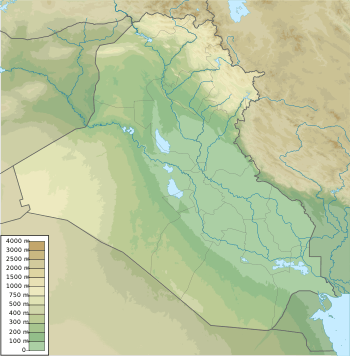Tell Ishchali
Tell Ishchali is an archaeological site in Diyala Province (Iraq). It is thought to be ancient Nerebtum or Kiti and was part of the city-state of Eshnunna. It was occupied during the Old Babylonian period.
Nerebtum/Kiti (?) | |
 Shown within Iraq | |
| Location | Diyala Province, Iraq |
|---|---|
| Region | Mesopotamia |
| Coordinates | 33°18′11″N 44°35′03.3″E |
| Type | tell |
| Area | 23 ha (57 acres) |
| Site notes | |
| Excavation dates | 1934–1935 |
| Archaeologists | T. Jacobsen, H. Hill |
Ancient name
At first, the site of Ishchali was thought to be Khafajah. Upon discovery there of a date formula that read "year that king Ishme-Bali built the great wall of Nerebtum", that designation became popular. Currently, scholarly opinion is split between Nerebtum and Kiti as the result of many tablets from the temple of Inanna of Kiti being analyzed. The name of Sadlas has also been proposed.
History of archaeological research
Items from illegal excavations at Ishchali began appearing on the open market in the 1920s, including many clay tablets. To pre-empt this activity, the Iraq expedition of the Oriental Institute of Chicago conducted two seasons of excavations there in 1934 and 1935. The expedition was led by Henri Frankfort and the work at Ishchali was handled by Thorkild Jacobsen and Harold Hill, all of the Oriental Institute.[1][2]
Tell Ishchali and its environment
.jpg)
The site lies about 3 miles (4.8 km) south and 7 miles (11 km) east of the modern city of Baghdad and 15 miles (24 km) southeast of Eshnunna on the Diyala River, a tributary of the Tigris. The main tell at Ishchali measures roughly 600 by 300 metres (1,970 ft × 980 ft). There are also small mounds to the north and south of it. The entire site covers around 23 hectares (57 acres).
History of occupation
Surface finds indicate that Ishchali may have been occupied as far back as the Akkadian period, but all excavated epigraphic evidence dates to the Old Babylonian period. While some tablets mention early local rulers, for most of the known history of Ishchali kings from Eshnunna held sway there, including Ipiq-Adad and Ibal-pi-El.
The most notable feature of Ishchali is the main temple. It was that of Inanna-Kitium, or Inanna of Kiti. It is one of the largest temples ever found in the ancient Near East. Rebuilt several times, always following the original plan, the monumental building consisted of one large upper temple and two smaller areas which are thought to be shrines. The many tablets found there give an excellent picture of temple life. A number of cylinder seals dating from the Early Dynastic to the Larsa period were also found there, assumed to be relic donations to the temple. There was also a smaller temple to the local city-god version of the god Sin.
Material culture
Of the 280 tablets excavated, 138 went to the Oriental Institute with the remaining 142 assigned to the Iraq Museum. The tablets illegally excavated from Ishchali are in many locations including the Lowie Museum of Anthropology at Berkeley, the Musée d'Art et d'Histoire in Geneva, Iraq Museum, Oriental Institute, and the Free Library of Philadelphia.[4]
Artifacts from Ishchali
- Four-faced goddess, Ishchali, Isin-Larsa to Old Babylonia periods, 2000-1600 BC, bronze - Oriental Institute Museum, University of Chicago
- Storm god, Ishchali, Isin-Larsa to Old Babylonian, 2000-1600 BC, baked clay - Oriental Institute Museum, University of Chicago
- Plaque with bull-men holding a palm trunk with sun disk, Ishchali, Isin-Larsa to Old Babylonian, 2000-1600 BC, baked clay - Oriental Institute Museum, University of Chicago
- Storm god, Ishchali, Isin-Larsa to Old Babylonian, 2000-1600 BC, baked clay - Oriental Institute Museum, University of Chicago
See also
- Cities of the ancient Near East
- Short chronology timeline
References
- OIC 20. Progress of the Work of the Oriental Institute in Iraq, 1934/35: Fifth Preliminary Report of the Iraq Expedition, Henri Frankfort (Oriental Institute Communication 20), Oriental Institute of the University of Chicago, 1936
- OIP 98. Old Babylonian Public Buildings in the Diyala Region: Part 1 : Excavations at Ishchali, Part 2 : Khafajah Mounds B, C, and D (Oriental Institute Publication 98), Oriental Institute of the University of Chicago, 1990, ISBN 0-918986-62-1
- Roux, Georges (1992). Ancient Iraq. Penguin Books Limited. p. 204. ISBN 9780141938257.
- Maria deJong Ellis, The Archive of the Old Babylonian Kitium Temple and Other Texts from Ishchali, Journal of the American Oriental Society, vol. 106, no.4, pp. 757-786, Oct/Dec 1986
Further reading
- Samuel Greengus, Old Babylonian tablets from Ischali and vicinity, Nederlands Historisch-Archaeologisch Instituut, 1979, ISBN 90-6258-044-0
- Samuel Greengus, Studies in Ishchali Documents, Undena Publications, 1986, ISBN 0-89003-166-5
- Paolo Gentili, A Catalogue of the Ishchali Texts in the Iraq Museum, Journal of Near Eastern Studies, vol. 63, no.4, pp. 257–75, 2004
- Maria deJong Ellis, The Goddess Kitium Speaks to King Ibalpiel: Oracle Texts from Ishchali, MARI 5, pp. 235–266, 1986